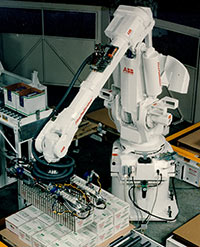
7 Industrial Robotics Hazards and How to Avoid Them
Steven Hogg | 05 January 2011
As industrial robots become more popular, many customers wonder whether robots are safe to implement in their facility. Although an industrial robot will improve the ergonomic conditions in a production area, there is a perception that the robot will create an unsafe work environment. This perception is fueled by the robots open programmability in terms of speed and direction, which appears impossible to control.
In order to ease concerns, a risk assessment should be performed during the development of the robotic work cell. At each stage of the assessment, individual safety requirements will be identified and the appropriate guarding and safety devices are determined in order to reduce the potential hazards. These requirements should be based off of OSHA and ANSI/RIA safety standards in order to provide the safest work cell possible.
OSHA identifies 7 potential hazards within robotic work cells:
-
Human Errors
Human error occurs in day-to-day activity and this is no different with regard to a robotic work cell. Whether it is programming, preventative maintenance, or teach pendant control, operators have the potential to place themselves in hazardous positions due to over familiarity or lack of knowledge of the robot’s motion path.
-
Control Errors
Errors in the controls software and hardware can lead to hazards within a robotic work cell. If the controls system faults, the system response may lead to a dangerous working environment if it is closely coupled with human interaction.
-
Unauthorized Access
Access by an unauthorized operator into a safeguarded robotic work cell. If an operator is unfamiliar with the safety hardware associated with the robotic work cell, they can find themselves in a dangerous and potentially fatal area.
-
Mechanical Failures
During the design and programming stages, mechanical part failure is not always taken into account. When an unexpected failure occurs, this can lead to a potentially hazardous situation for the operator.

-
Environmental Sources
Outside factors and communication interference can create an undesirable effect on a robotic work cell. Unsuppressed power surges or power loss can lead to injury if they are not planned for during the initial stages of the project.
-
Power Systems
Power sources that have communication to the robotic cell can be disrupted and lead to undesired actions. This can produce a release of energy, creating a hazardous environment for an operator.
-
Improper Installation
Any time an industrial robot is installed it is vital to the success of the project and safety of the operators that the system is installed correctly before it is fully operational. If the robotic work cell is incorrectly setup, future hazards may occur due to variance from the original design.
Although each of these potential hazards can be dangerous, they are each preventable as long as workers are well educated on the robotic system and the robotic integrator has fulfilled all job requirements, including proper installation, programming, and risk assessment. Any dangers should also be taken into account during the initial design phase and shared as a living document throughout the project life cycle.
As long as these seven potential hazards are addressed early, industrial robots are extremely safe and can help your bottom line. Before our clients purchase an industrial robotics system, we always encourage them to become familiar with these safety standards and practices, but no matter what robotic integrator you use, ensure they fully understand and are held accountable to these standards.
For more information on industrial robotics systems and safety, please contact us. You can also learn more about preventing robotic hazards in our article "Improve Your Automation System Safety with These 4 Components".
Steven is the Applications Manager for Robotics at Bastian Solutions. He helps lead the robotics automation solutions for picking, packing, palletizing, machine tending, turnkey options and more. He has a Bachelor of Science in Industrial and Manufacturing Systems Engineering from the University of Missouri-Columbia.
Comments
Donald Giovanoni says:
8/28/2018 10:07 AM
Releated to comments number 1 and 2, inadequete testing can be a contributing factor.
Mike Yeh says:
8/28/2018 10:07 AM
If you could adopted more modulars end of arm tooling components, that will be more perfect. Please try to adopt acy corporation EOAT parts.
Steven Hogg says:
8/28/2018 10:07 AM
Mike - Bastian Robotics is always interested in evaluating new technologies in order to improve the components used in our EoATs. Please email me your companies catalog for further evaluation.
Leave a Reply
Your email address will not be published.
Comment
Thank you for your comment.